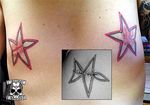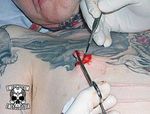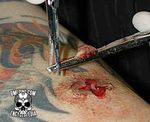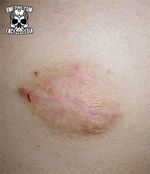Nipple nullification
Nipple removal is the amputation of all or part of the nipple. It is primarily a male activity since nipple removal in women could easily lead to mastitis.
Procedurally most people use a clamp and cut type procedure where the nipple is clamped off (or simply tourniquetted off) below where it is to be excised. Once the clamp is in place, the nipple is cut off, and the incision may be sutured. Other people skip the clamp entirely, and still others use different methods including cautery (ie. burning off the nipple).
Even with local anesthetics the procedure can be quite painful, although some people find they are able to totally numb it even with just EMLA cream and a tourniquet. Bleeding may continue for several days afterwards depending on the procedure used, and healing usually takes about a month. The resultant healed removal can look like anything from a small healed cut to a large scar-tissue nipple.
While some people lose sensation, it is not at all abnormal for the healed scar to be highly sensitive — sometimes even more sensitive than the original nipple was!



